Nursery finds success going back to bush basics
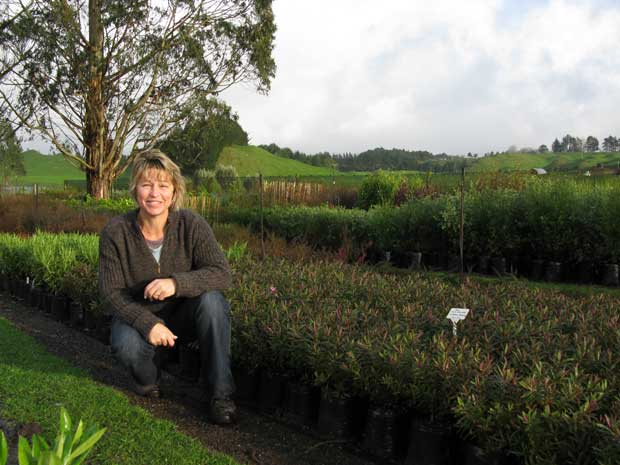
The secret to Diane Coleman’s successful tree nursery business is in the way she’s grown it.
Words: Nadene Hall Photos: Tracey Robinson
When Diane Coleman started her tree nursery business 20-odd years ago, she was hoping to create a job that would give her some flexibility when it came to caring for her then-five year old son during school holidays or if he was home sick.
She had to get a $5000 loan to buy the potting mix and her builder husband John put up a small tunnel house. Things were so tight she also raised calves to help finance her dream.
“It seemed like a lot of money at the time, but with raising calves and that small loan we were able to get enough supplies to start growing seedlings and I grew 10,000 and I sold them all.”
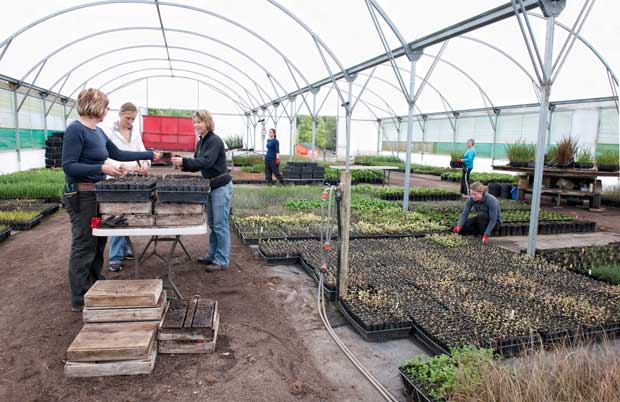
Diane started her business with a $5000 loan to buy potting mix, now she produces hundreds of thousands of seedlings.
In 2013, Diane’s company – Treeline Native Nursery – won the Rural Women NZ Enterprising Rural Women Award.
“I won the Love of the Land category but I really didn’t think I would win the supreme award, it was a big surprise – there were some really good businesses there.”
It was taking her opportunities and, most importantly says Diane, starting small that have been the keys to her success. She trained in horticulture when she left school and worked for several other nurseries before beginning her business, but she says starting with a small investment that she could afford to work with was very important.
“I certainly had the qualifications to do what I did, but it was just seizing the opportunity and watching it grow. I didn’t realise where it was going to head – I did hope! It’s a case of grabbing those opportunities because they don’t come by very often, having confidence, and starting off small – a lot of people jump in really big and it falls over after a couple of years, but if you just grow the business in stages… this started off as a seedling nursery and I was sure I could earn enough to equal three days at my other job so I took that opportunity.”
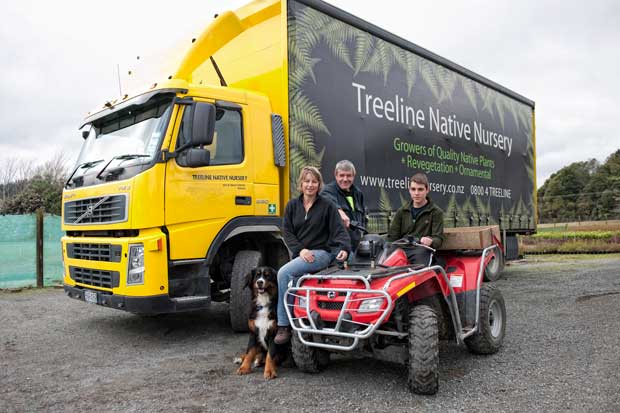
One of those opportunities was the-then expanding market for native trees for revegetation projects, and that saw the nursery go from producing just a few varieties in 1996 to having more than 120 in its catalogue today.
“To start with we knew there was a shortage of native revegetation plants – it was when waterways were first being planted up. We made contact with Environment Bay of Plenty (the regional council) and they told us to grow some and they would see what they needed – they took the whole lot and the next year we grew 25,000 and they took all of those and so on every year. They remained our biggest customer, right up until about three years ago when there was a downturn, but by then we’d got a lot of other customers.”
Another key to the success of the business has been selling in bulk as when you grow 350,000 trees a year, size matters.
“We mostly grow native trees to PB2-PB3 (planter bag size 2 and 3) which gives you a one year old tree, anything around 40-60cm high, and we wanted to sell in bulk as we could see that was our main market. We do grow bigger grades and we do grow some ornamentals and we do grow smaller grades, but that (size) is our main market.”
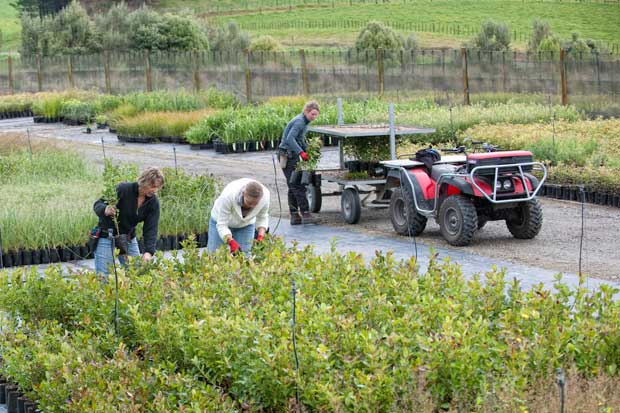
The PB2-PB3 size gives Diane’s customers value for money. A year-old tree is a reasonable height and has a good root system in place so it’s able to take on competition such as long grass, but it can still be priced competitively, especially when bought in large numbers.
The recession in recent years has meant a slight change in tactics, as Diane didn’t want to have to raise her prices, but she also had rising costs.
“We were growing 300,000 in 2009-2010 and we put perhaps 250,000 of them into PB2 and PB3 bags. The next year we cut back to 180,000 and did 120,000 in root trainers so we could still offer the same number of plants. We didn’t have as many in our premium grade but we did meet the market for people who wanted plants in root trainers because they were half the price ($1.15 vs $2.95), and on the flip side, if we didn’t sell them we weren’t stuck with them – we could bag them up for the following year.
“If people are prepared to look after root trainer stock, especially if they live in a warmer area, they can get away with it, but in some areas it’s not worth it.”
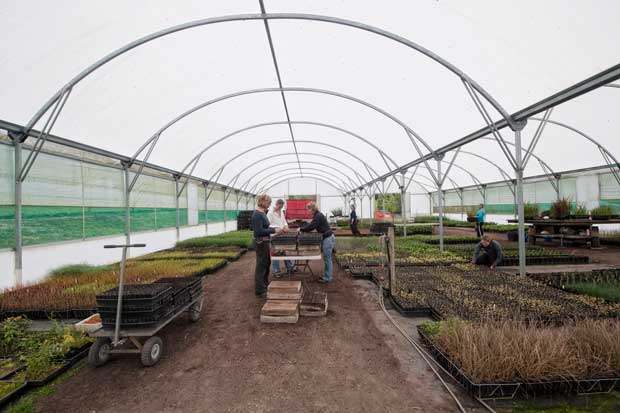
The number one seller for Treeline is flax, making up about 15% of total sales, with manuka second (10%), and kanuka and cabbage trees not far behind.
“They’re the nurse crops, the fast growing natives, they’re quick to establish and great for things like wetlands. Wetland and riparian species are still our biggest sellers.”
Diane decides what to grow based on several factors including what happened the year before, what sold (or didn’t), repeat sales and how much contract work they have planned. She says customers do want to try different species but they might not work as well as the tried and true.
“A few years ago akeake was really popular whereas now we’re only growing maybe 1000 this year. There’s nothing wrong with it, it’s just marginally frost tender so after three years you might have a beautiful plant and then you have a bad winter and it just knocks it out.”
The nursery now covers about 2ha (5 acres) of the Coleman’s block, but when they started out it was just Diane and a 60m² tunnel house.
“John designed and built that one, then we built another one, then at the five year mark John built quite a big one, it’s about 20m by 20m (400m²), and then three years ago we bought our first-ever metal-framed one off Redpath, it’s 33m long by about 20m wide and that’s amazing.
“We progressed the business the same way: when we first started I used to shovel the potting mix onto tables until we could afford to buy a bucket for our old farm tractor. Now we’ve got a lovely brand new tractor that does all the heavy work so our progression has been slow but steady.”
The young plants are sown and spend their first few months in the tunnel houses but most of the nursery is outside in open beds that have also steadily grown bigger over the years.
“I never imagined we would be growing this amount of trees or be hiring staff – we’ve moved the fence lines so many times! – but I think we’ll stay as we are and do things better, I’m quite happy with the numbers we’re growing now… but we do have a lot more room.”
As the nursery has grown, Diane says they have discovered that bigger is not always better.
“The bigger you get the more of a microclimate you’re creating, and then when you grow a lot of one species, if you get botrytis or other fungal problems then you’re going to have to spray. We never used to have to spray much and we keep it to a minimum now – it’s not something anyone likes to do but it is a reality.”
Everyone’s favourite job is collecting the seeds required to grow most of their stock, eco-sourcing it from areas where they have clients so the plants are genetically able to cope with the conditions of where they are going to be planted.
“The first year we bought in seed from a reputable source… the second year we started collecting our own. We’re quite keen bush walkers and we could see so many seeds in the bush and that’s now a really important part of our job.”
“We go to designated places, whether it be off the side of the road, or we deal with farmers. We always ask if we can go onto a property to collect the seed.
“Everyone loves going seed collecting – it’s a day off nursery work so everyone puts their hand up for that job. It’s tiring but exciting. We’ll collect a rubbish bag full when some are one seed per capsule, but some seed is very small so we weigh it to get an idea of seeds per gram.”
What happens next depends on the seed. Some like manuka and kanuka can be sown straight away, others like karamu need to be kept moist, some need to stratify (chill) in the fridge for 5-6 weeks, some like it light, some like it dark, and some need their pods put in boiling water (kowhai).
“We also do cuttings of things like hebes and flowering manukas, and we buy in growing lines if we can’t grow something ourselves but we want to have it in the nursery. Things like miro can take up to five years to germinate and it’s quite difficult to get it to germinate so we buy off a nursery who seem to have it worked out. Rimu seeds once every seven years and you’ve got to find the right tree in that seventh year or you miss out, so we usually buy it from a good local source.”
Once seeds have germinated and the seedlings are big enough, they are taken out of their root trainer pots, bagged up and put outside in the main nursery. When they first started all the work was done by hand but now Diane and her staff – three full-time and up to seven part-time when it’s busy – get help from some mechanisation. John and an engineer worked on designing a hopper so that a person can stand while filling root trainer containers rather than having to bend and shovel.
“We now have two bikes that pull double decker trolleys, whereas when we started we had to use handcarts to move everything around the nursery, but we got so big that wasn’t practical.”
As staff work on repotting seedlings or larger plants, they are constantly grading them to ensure the plants are the right size and good quality. If plants are smaller than average, they are separated out to give them time to grow.
“We’re very hot on grading in sizes, right from the pricking out stage to root trainers to bags, so customers get plants that are the same height, not some that are 20cm and some that are 50cm, we want to get a good quality product. We can grow hardy plants because we’re at high altitude (over 400m above sea level) so our plants can go north or south.”
She might be the award-winning CEO of her own company but Diane spends much of her day working at the coal face.
“I do all the office work and wages and accounts, but I would say four out of five days I’m in the nursery working. I do all the seed sowing too. The responsibility does all come down to me, but I do have a wonderful second in command, Sue, so if I’m not here she’s in charge, and we work the role together when it comes to production.”
There’s very little downtime in a nursery business this big – a week-long trip to Melbourne in July was Diane and John’s first break in a while – and even though winter is when customers want plants, it’s summer that is their busiest time.
“In summer to late autumn we’re collecting seed, then sowing it from autumn through to spring, then we’re pricking out seedlings from mid-winter through to summer, then we’re bagging trees from spring through to autumn. We used to have quiet times but now we don’t which is good – a lot of businesses aren’t busy and we’re lucky.”
One area she admits isn’t her strength is marketing. “We’ve done a lot of advertising… we started off with Environment Bay of Plenty as our only customer and they have been amazing advocates for our business, but I just can’t speak highly enough of word of mouth. It’s usually someone telling somebody.”
Another recent move has also paid off in spades, although it took John – who now works full-time in the business – a bit of time to convince Diane to spend a lot of money when things were at their tightest.
“We bought a big truck! We were finding 3-4 years ago we were becoming uncompetitive because of rising freight costs when petrol prices went up. It was John’s idea to get a truck… and it has been amazing, we were able to offer our customers a good price for freight. In the first year we picked up a job for 42,000 plants because we offered free freight and we wouldn’t have got that job otherwise.
“It’s got curtains on the side with Treeline on it and it looks amazing driving down the road, it’s been a great advertising tool.”
The bulk of sales come from winning tenders for large-scale revegetation projects, although this is getting harder as bigger companies have taken over the market.
“We’re looking at getting a potting machine because we’re finding that’s a big cost time-wise. This is a very labour-intensive industry and our margins are getting less and less so the only way to be competitive is to mechanise. We’ve held our prices for the last five years because of the recession but it’s getting to the point where we have to do something.”
Diane feels positive about her company’s future, and she’s now expanding their seed gathering to take in a wider part of the Waikato so more people can buy plants eco-sourced from their area.
“I think because the business has grown every year, I’ve just grown with the role. Growing plants is a natural thing that I love doing, it’s my passion really. I’ve got a head for figures so I’ve grown too and I haven’t found it too difficult.
“From 10,000 plants to 350,000 now, you have to stop and think sometimes, we’ve come a long way. You just think next year I’ll grow a few more, I was never expecting to get this big. I’m not saying it’s not stressful, and it’s a lot of hard work and long hours, but that’s the privilege of having your own business.”
DIANE’S ONE EXOTIC EXCEPTION
There is one non-native that Diane grows in the nursery: tree lucerne/tagasaste (Chamaecytisus palmensis).
“People like to use it amongst natives because it’s very fast growing – it’s a lot faster than the fastest-growing natives – the wood pigeons love it and you get a lot of cover. We can’t grow enough of it, there’s been a huge demand.
“The great thing is after about seven years it dies down and it’s not invasive so the natives take over.”
Love this story? Subscribe now!
 This article first appeared in NZ Lifestyle Block Magazine.
This article first appeared in NZ Lifestyle Block Magazine.

